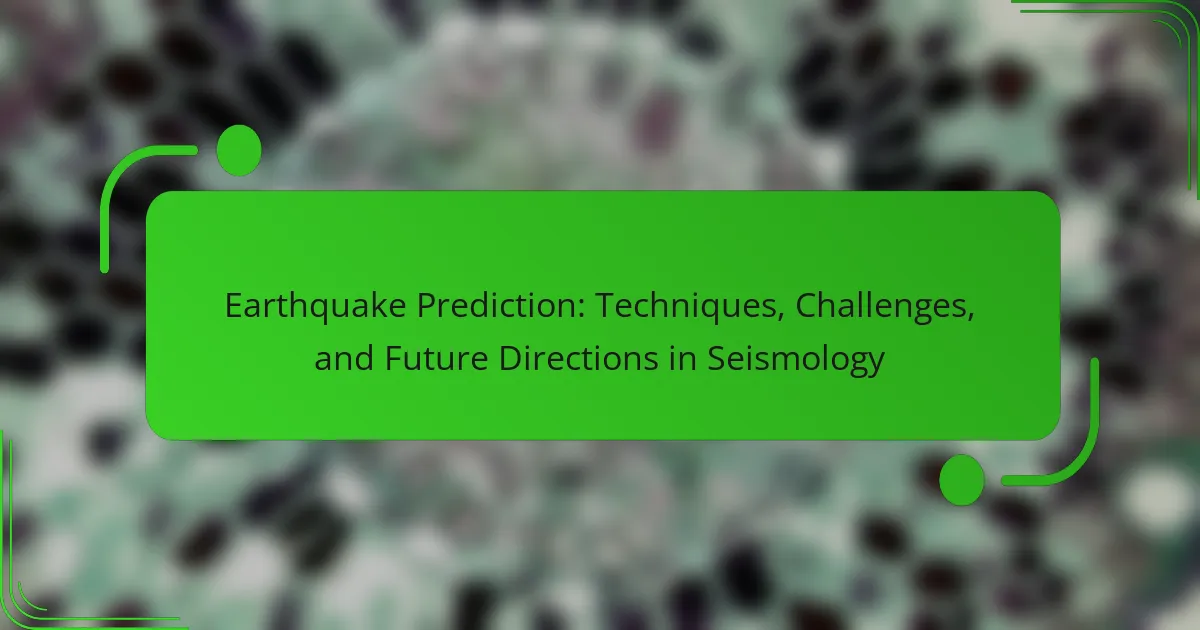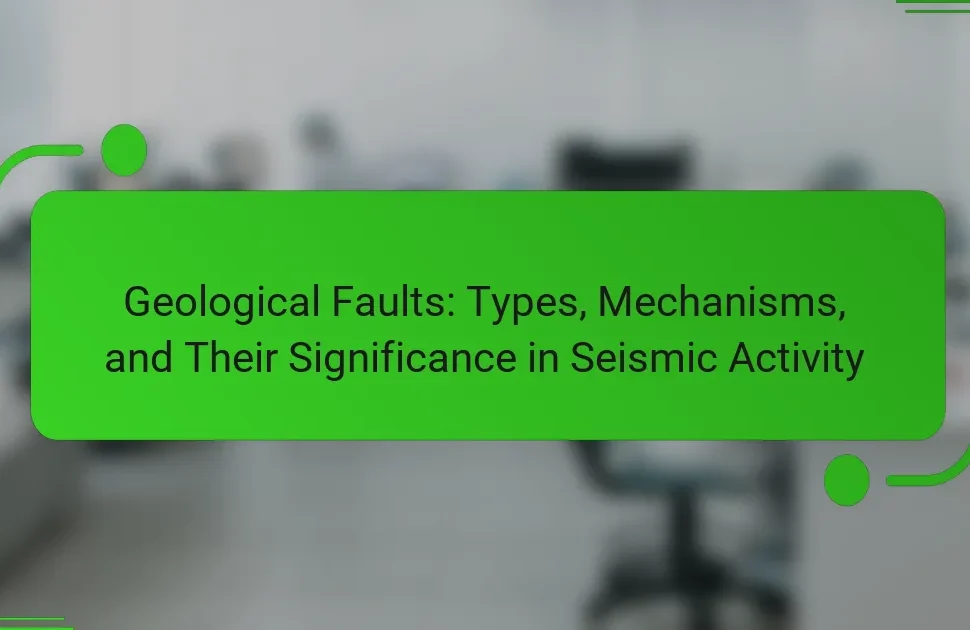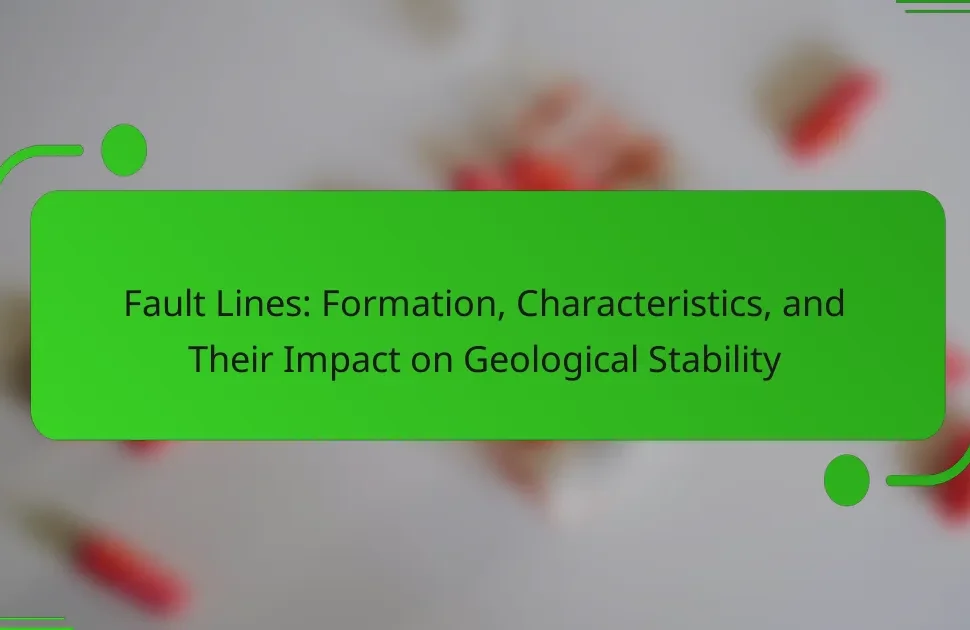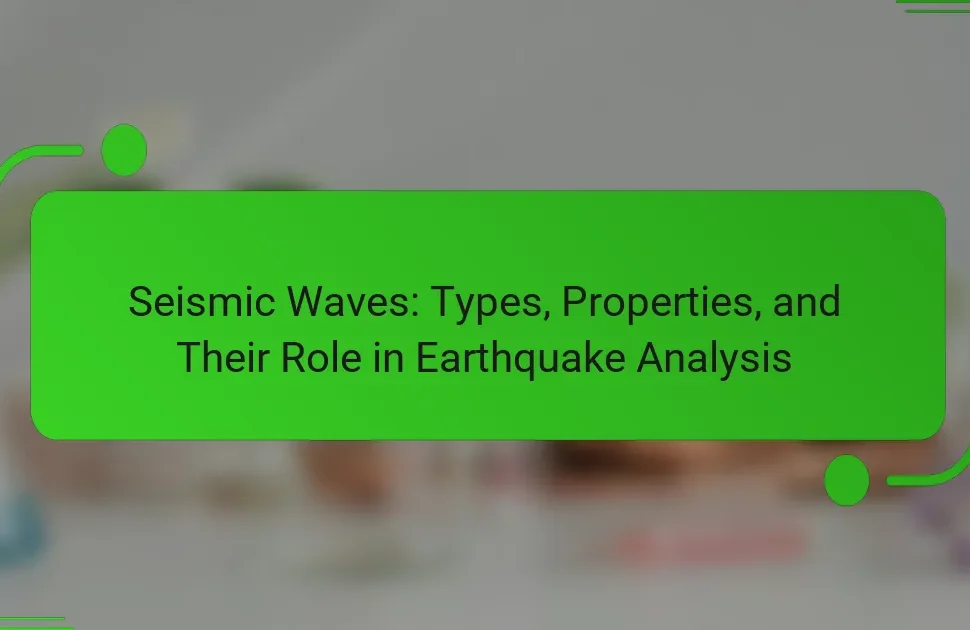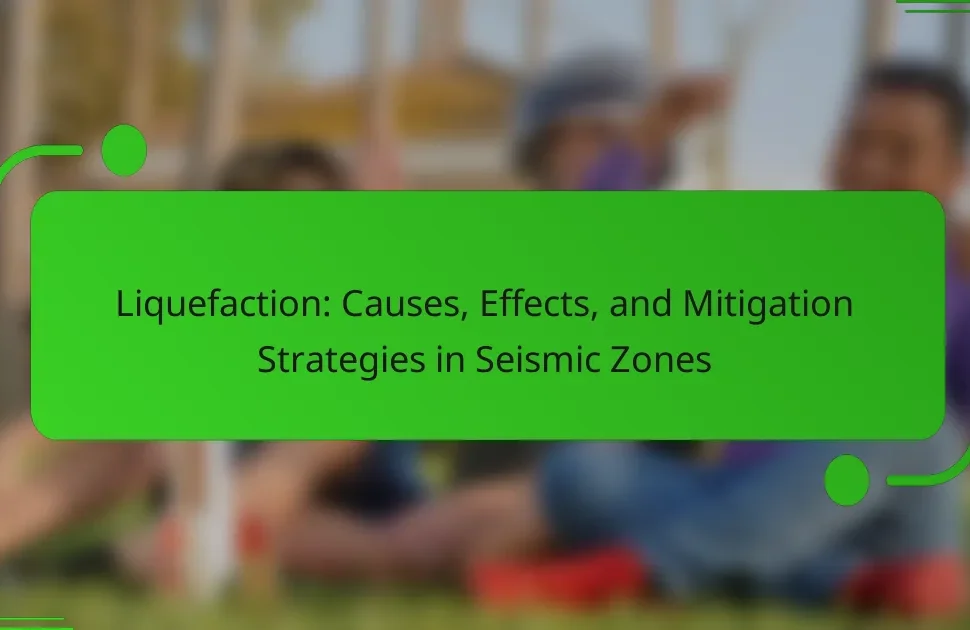Earthquake prediction is the scientific process of forecasting the occurrence of earthquakes by analyzing geological data and seismic activity patterns. This article explores various techniques employed by seismologists, including seismic monitoring, historical data analysis, geophysical methods, and machine learning algorithms, which aim to improve prediction accuracy. Despite technological advancements, challenges persist in accurately forecasting the timing and location of earthquakes due to the complex nature of seismic activity and the variability of tectonic plate interactions. The article also discusses the limitations of current predictive models and the ongoing research efforts aimed at enhancing preparedness for future seismic events.
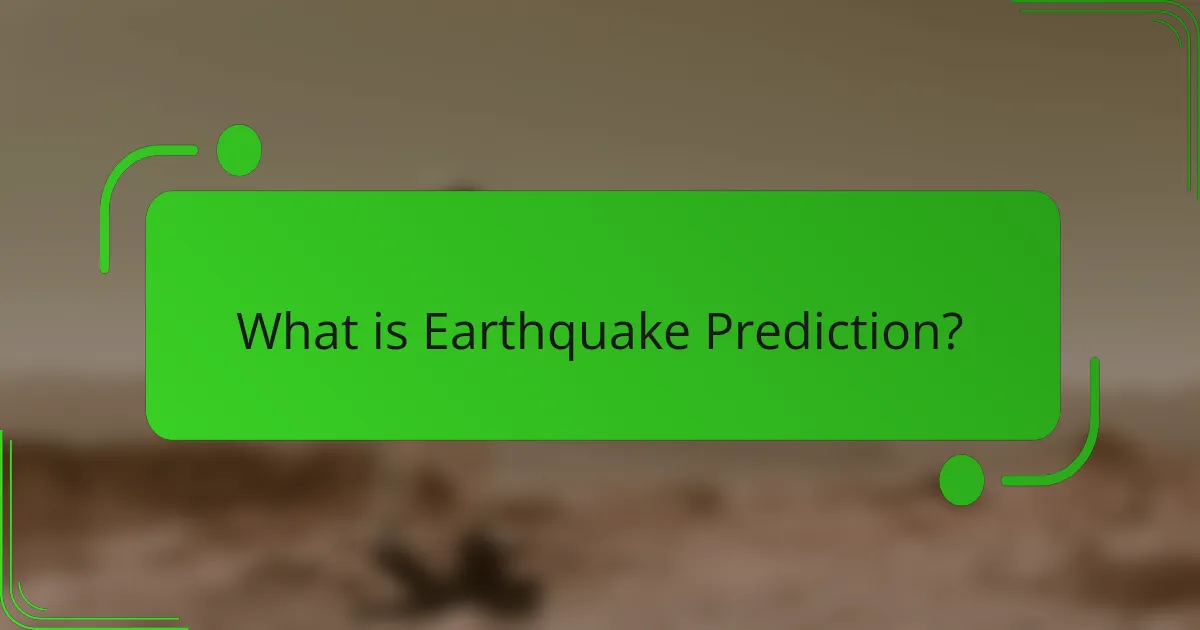
What is Earthquake Prediction?
Earthquake prediction is the process of forecasting the occurrence of an earthquake. It involves analyzing geological data and seismic activity patterns. Scientists use various methods to assess the likelihood of future earthquakes. These methods include monitoring fault lines and studying past seismic events. Despite advancements, accurate prediction remains challenging. Current techniques can estimate probabilities but not precise timing. Historical data shows that major earthquakes often occur without warning. Research continues to improve predictive models for better preparedness.
How is Earthquake Prediction defined in seismology?
Earthquake prediction in seismology is the attempt to forecast the occurrence of earthquakes. This involves identifying the time, location, and magnitude of potential seismic events. Various methods are used, including statistical analysis of historical data and monitoring of geological activity. Predictive models rely on understanding tectonic plate movements and stress accumulation in the Earth’s crust. Despite advancements, accurate prediction remains a challenge. Research indicates that while short-term predictions are difficult, long-term forecasts can provide valuable information. The complexity of geological systems contributes to the unpredictability of seismic events.
What are the historical perspectives on Earthquake Prediction?
Historical perspectives on earthquake prediction reveal a progression from ancient observations to modern scientific methods. Early civilizations, such as the Chinese and Greeks, noted patterns in animal behavior and natural phenomena before earthquakes. In the 20th century, advancements in seismology led to the development of seismic networks. These networks allowed for better data collection and analysis. The 1970s saw the introduction of the concept of foreshocks, which are smaller earthquakes preceding a larger event. Research in the 1990s focused on statistical models and the identification of precursors. Despite advances, reliable prediction remains elusive. The unpredictability of earthquakes has led to ongoing research and technological development in the field.
What are the key terms related to Earthquake Prediction?
Seismic activity, foreshocks, and aftershocks are key terms related to earthquake prediction. Seismic activity refers to the frequency and intensity of earthquakes in a region. Foreshocks are smaller tremors that occur before a larger earthquake. Aftershocks are smaller earthquakes that follow the main shock. Other important terms include seismic waves, which are energy waves generated by earthquakes. Magnitude measures the energy released during an earthquake. Intensity assesses the earthquake’s effects on people and structures. Prediction models utilize historical data to forecast potential earthquakes. Monitoring networks track seismic activity in real-time.
Why is Earthquake Prediction important?
Earthquake prediction is important because it can save lives and reduce economic losses. Accurate predictions allow for timely evacuations and preparedness measures. For instance, the 1994 Northridge earthquake in California caused $44 billion in damages. Early warning systems can mitigate damage by alerting people seconds before shaking starts. Research indicates that effective prediction can significantly lower casualties during seismic events. Countries like Japan have invested in advanced prediction technologies, showcasing their importance. Overall, earthquake prediction plays a crucial role in disaster management and public safety.
What are the potential impacts of accurate Earthquake Prediction?
Accurate earthquake prediction can significantly reduce loss of life and property damage. Early warnings allow for timely evacuations and preparedness measures. For instance, Japan’s earthquake early warning system has saved countless lives since its implementation. Accurate predictions can also enhance infrastructure resilience by enabling retrofitting before seismic events. Research indicates that predictive models can improve emergency response coordination. The National Earthquake Information Center reports that timely alerts can decrease economic losses. Accurate predictions foster public awareness and education about earthquake risks. Overall, the societal benefits of accurate earthquake prediction are profound and wide-reaching.
How does Earthquake Prediction contribute to public safety?
Earthquake prediction enhances public safety by providing advance warnings of potential seismic events. These warnings allow individuals and communities to take precautionary measures. For instance, people can evacuate buildings or move to safer locations. Emergency services can prepare for immediate response actions. Infrastructure can be reinforced to withstand potential damage. Research indicates that effective prediction can reduce casualties and property loss. The 1994 Northridge earthquake demonstrated that timely alerts could save lives. Overall, earthquake prediction is crucial for minimizing risks associated with seismic activity.
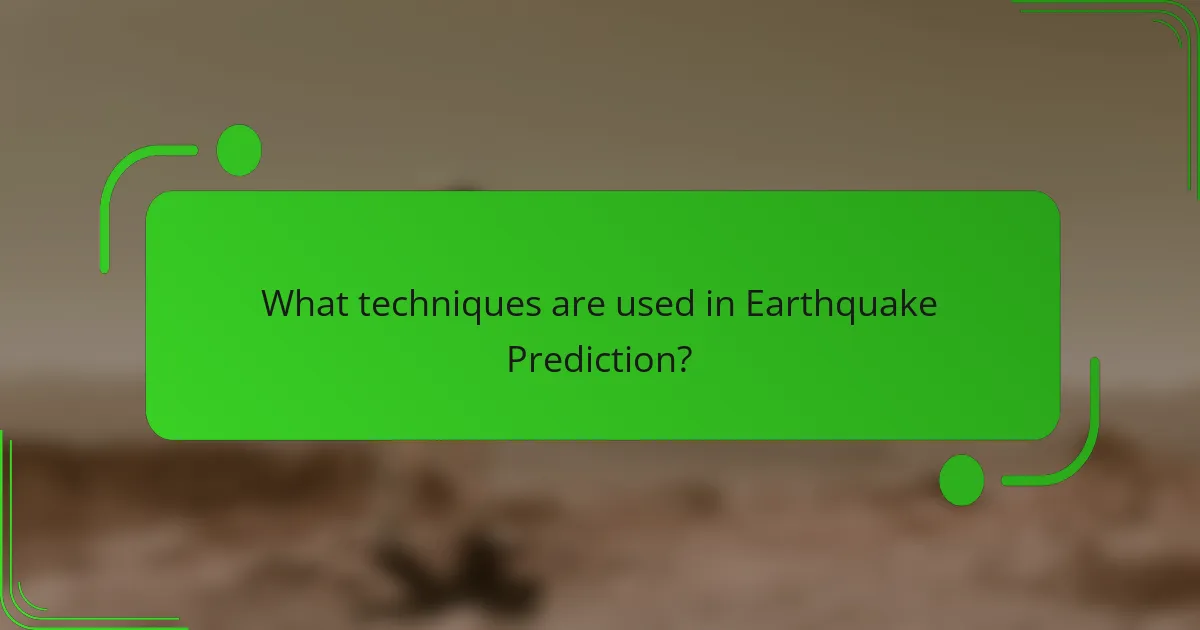
What techniques are used in Earthquake Prediction?
Seismologists use various techniques for earthquake prediction. These include seismic monitoring, which involves using seismographs to detect and analyze ground movements. Historical data analysis is another technique, where past earthquake patterns inform predictions. Geophysical methods, such as GPS and satellite imaging, help measure tectonic plate movements. Machine learning algorithms analyze vast datasets to identify potential precursors. Additionally, researchers study foreshocks, which sometimes precede larger quakes. Each of these techniques contributes to understanding seismic activity and improving prediction accuracy.
What are the primary methods of Earthquake Prediction?
The primary methods of earthquake prediction include seismic monitoring, statistical analysis, and geophysical methods. Seismic monitoring involves the use of seismographs to detect and analyze earthquake activity. This technique provides real-time data on seismic waves and helps identify patterns. Statistical analysis examines historical earthquake data to identify trends and probabilities of future events. Geophysical methods utilize techniques like GPS and ground deformation measurements to assess tectonic movement. These methods have been employed to enhance prediction accuracy, although precise prediction remains challenging due to the complex nature of seismic activity.
How does seismic monitoring contribute to prediction efforts?
Seismic monitoring contributes to prediction efforts by providing real-time data on earth movements. This data helps scientists analyze patterns and identify potential earthquake precursors. Monitoring systems detect seismic waves and measure ground motion. The information collected can indicate stress accumulation along fault lines. Historical data from seismic monitoring has shown correlations between certain signals and subsequent earthquakes. For example, increased seismic activity often precedes larger seismic events. By using advanced algorithms, researchers can improve prediction models based on this data. Ultimately, seismic monitoring enhances the understanding of earthquake dynamics and risk assessment.
What role does statistical analysis play in Earthquake Prediction?
Statistical analysis plays a crucial role in earthquake prediction. It helps identify patterns and correlations in seismic data. By analyzing historical earthquake records, statisticians can estimate the probability of future seismic events. Techniques such as time series analysis and regression models are commonly used. For example, the Gutenberg-Richter law describes the relationship between earthquake magnitude and frequency. This statistical model provides insights into the expected size and occurrence rates of earthquakes. Additionally, machine learning algorithms utilize statistical methods to improve prediction accuracy. Studies have shown that incorporating statistical analysis enhances the reliability of earthquake forecasts.
What technologies are employed in Earthquake Prediction?
Seismology employs various technologies for earthquake prediction. These include seismic sensors that detect ground vibrations. GPS systems monitor tectonic plate movements. Satellite imaging provides data on land deformation. Machine learning algorithms analyze historical earthquake data for patterns. Neural networks enhance predictive modeling accuracy. Remote sensing techniques assess environmental changes preceding earthquakes. Each technology contributes to a comprehensive understanding of seismic activity.
How do satellite systems enhance Earthquake Prediction?
Satellite systems enhance earthquake prediction by providing real-time data on ground deformation. These systems use Synthetic Aperture Radar (SAR) to measure minute changes in Earth’s surface. This technology allows scientists to detect stress accumulation along fault lines. The data collected helps in modeling seismic hazards more accurately. For instance, the European Space Agency’s Sentinel-1 satellites have shown significant improvements in monitoring tectonic movements. Additionally, satellite observations can identify patterns that precede earthquakes. Research indicates that integrating satellite data with ground-based measurements increases prediction reliability. This combination leads to better preparedness and risk mitigation strategies.
What advancements in data analytics are improving prediction accuracy?
Advancements in data analytics improving prediction accuracy include machine learning algorithms and real-time data processing. Machine learning models can analyze vast datasets to identify patterns that traditional methods might miss. These models enhance prediction accuracy by learning from historical earthquake data. Real-time data processing allows for immediate analysis of seismic activity as it occurs. This capability leads to quicker and more accurate predictions. Additionally, the integration of big data technologies supports the handling of large datasets from various sources. Research shows that combining these technologies significantly improves forecasting models. For instance, a study published in the Journal of Seismology demonstrated a 30% increase in prediction accuracy using advanced analytics techniques.
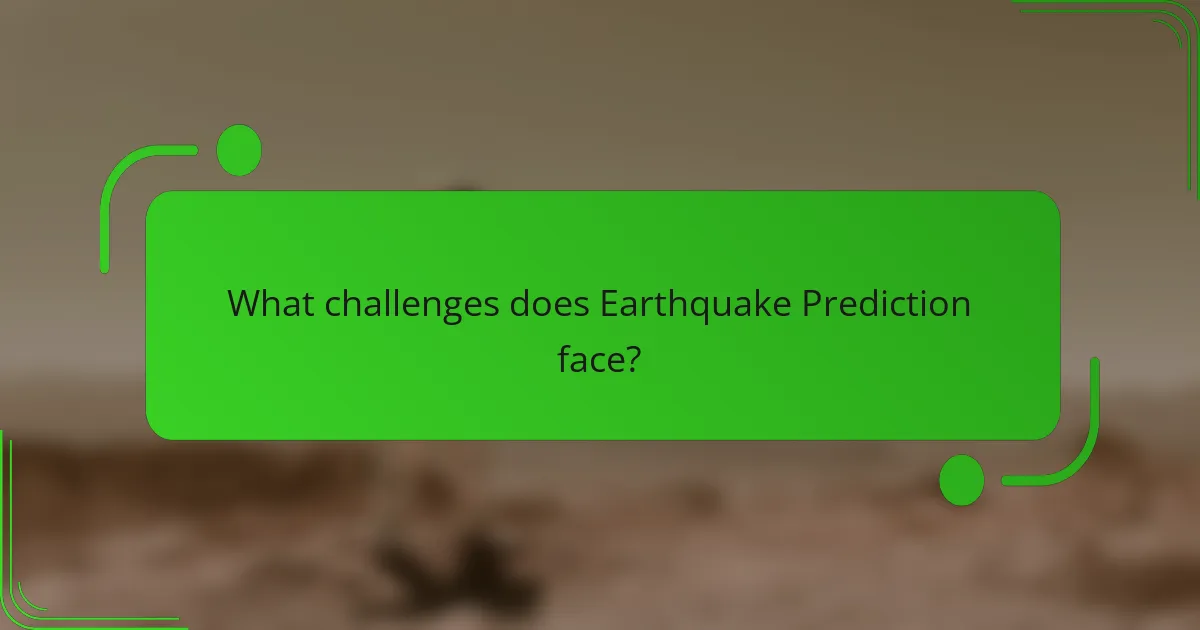
What challenges does Earthquake Prediction face?
Earthquake prediction faces significant challenges due to the complex nature of seismic activity. Predicting earthquakes requires understanding intricate geological processes. Current technology struggles to accurately forecast the timing and location of earthquakes. The lack of reliable precursors makes predictions uncertain. Additionally, the variability in tectonic plate interactions complicates predictions. Historical data is often insufficient for making accurate forecasts. Limited computational models hinder the ability to simulate seismic events effectively. Funding and resources for research in earthquake prediction can also be inadequate. These factors collectively impede advancements in reliable earthquake prediction methods.
What are the limitations of current Earthquake Prediction methods?
Current earthquake prediction methods have significant limitations. They primarily lack accuracy in forecasting specific events. For instance, while scientists can identify regions at risk, pinpointing the exact time and magnitude of an earthquake remains elusive. Historical data shows that predictions often result in false alarms or missed events. Furthermore, the complex nature of tectonic processes makes it difficult to establish reliable patterns. The variability in geological conditions across regions adds another layer of uncertainty. Additionally, existing models rely heavily on past seismic activity, which may not always predict future occurrences effectively. Overall, these factors contribute to the ongoing challenges in achieving reliable earthquake predictions.
How do geological complexities hinder accurate predictions?
Geological complexities hinder accurate predictions by introducing uncertainties in seismic models. Variations in rock types, fault structures, and fluid movements complicate the understanding of stress accumulation. These factors can lead to unpredictable fault behavior. For instance, heterogeneous materials can cause wave propagation to vary significantly. This variability impacts the reliability of seismic hazard assessments. Additionally, the interaction between multiple faults can create unforeseen stress transfer scenarios. Historical data may not account for these complexities, leading to miscalculations. As a result, predicting the timing and magnitude of earthquakes becomes increasingly challenging.
What are the challenges in data collection for Earthquake Prediction?
Data collection for earthquake prediction faces several challenges. One major challenge is the variability of seismic activity. Earthquakes occur unpredictably, making it difficult to gather consistent data. Another challenge is the limitations of current technology. Instruments may not capture all seismic signals accurately, leading to gaps in data. Additionally, the vast geographical areas that need monitoring complicate data collection efforts. Environmental factors can also interfere with readings. For example, noise from human activities can obscure seismic signals. Furthermore, data integration from multiple sources can be complex. Different systems may use varying formats or standards, complicating analysis. Lastly, funding and resource limitations can hinder the establishment of comprehensive monitoring networks. These challenges collectively impact the reliability of earthquake prediction efforts.
Why is public perception a challenge in Earthquake Prediction?
Public perception is a challenge in earthquake prediction because it affects how people respond to warnings. Many individuals are skeptical about the accuracy of predictions. This skepticism can lead to complacency in preparedness efforts. Research shows that when predictions are perceived as unreliable, people are less likely to evacuate or follow safety protocols. For example, a study by the US Geological Survey indicated that public trust in seismic data influences evacuation rates during alerts. Additionally, misinformation can spread quickly, further complicating public understanding of risks. Overall, overcoming these perception issues is crucial for effective earthquake response and safety measures.
How do misconceptions affect the acceptance of prediction technologies?
Misconceptions significantly hinder the acceptance of prediction technologies. These misconceptions often stem from a lack of understanding of how prediction technologies function. For instance, many people believe that prediction technologies can provide precise predictions, which is not the case. This misunderstanding leads to skepticism regarding their reliability. Research indicates that when individuals perceive prediction technologies as inaccurate, they are less likely to trust and utilize them. Additionally, misconceptions can create fear or anxiety about the consequences of false predictions. For example, if people believe that prediction technologies will always fail, they may disregard valuable information. This cycle of misunderstanding ultimately limits the effectiveness of these technologies in disaster preparedness.
What strategies can improve public understanding of Earthquake Prediction?
Improving public understanding of earthquake prediction requires effective communication strategies. Educational programs can provide foundational knowledge about seismic activity. Workshops and seminars can engage communities directly, fostering interaction. Utilizing social media platforms can disseminate timely and relevant information. Visual aids, such as infographics, can simplify complex data for better comprehension. Collaborations with local governments can enhance outreach efforts. Public drills and simulations can demonstrate preparedness and response. Research indicates that informed communities are better equipped to respond to earthquakes, reducing panic and enhancing safety.
What are the future directions in Earthquake Prediction research?
Future directions in earthquake prediction research focus on integrating advanced technologies and data analysis methods. Machine learning techniques are being explored to improve prediction accuracy. Researchers are also utilizing big data analytics to analyze seismic patterns. Enhanced monitoring networks are being developed to provide real-time data. Studies are examining the use of satellite imagery for ground deformation analysis. Collaborative international efforts are increasing to share data and methodologies. Improved understanding of fault mechanics is essential for better predictions. Ongoing research aims to refine probabilistic seismic hazard assessments.
How can interdisciplinary approaches enhance Earthquake Prediction?
Interdisciplinary approaches can enhance earthquake prediction by integrating diverse scientific fields. This includes geology, seismology, engineering, and social sciences. Geologists provide insights into tectonic plate movements. Seismologists analyze seismic data for patterns and anomalies. Engineers contribute to developing resilient infrastructure that can withstand earthquakes. Social scientists study community preparedness and response strategies. By combining these perspectives, researchers can create more comprehensive models. For example, the incorporation of machine learning techniques from computer science improves data analysis. Collaborative efforts lead to better risk assessment and mitigation strategies. Enhanced communication among disciplines fosters innovative solutions for earthquake prediction.
What emerging technologies hold promise for the future of Earthquake Prediction?
Machine learning algorithms show promise for earthquake prediction. These algorithms analyze vast datasets to identify patterns. They can process seismic data more efficiently than traditional methods. Another emerging technology is satellite-based remote sensing. This technology monitors changes in the Earth’s surface. It provides real-time data that can indicate seismic activity. Additionally, IoT sensors are being deployed in earthquake-prone areas. These sensors collect data on ground vibrations and other relevant metrics. Their integration can enhance early warning systems. Research indicates that combining these technologies may improve prediction accuracy. For instance, a study by the US Geological Survey highlights the potential of machine learning in seismic forecasting.
What practical steps can individuals take regarding Earthquake Prediction?
Individuals can take several practical steps regarding earthquake prediction. They should stay informed about seismic activity in their region. Monitoring local geological surveys and seismological reports is essential. Individuals can also participate in community preparedness programs. These programs often provide training on earthquake safety and response. Creating an emergency plan for their household is crucial. This plan should include communication strategies and evacuation routes. Additionally, individuals should assemble an emergency kit with essential supplies. Regularly reviewing and updating this kit ensures readiness. Engaging with local emergency management agencies can provide further resources and support.
How can communities prepare for earthquakes based on prediction data?
Communities can prepare for earthquakes based on prediction data by implementing early warning systems. These systems utilize seismic data to provide alerts seconds before shaking occurs. For example, the ShakeAlert system in California can notify residents of impending quakes. Communities should also develop emergency response plans that incorporate prediction data. This includes conducting regular drills and educating residents on safety protocols. Infrastructure should be retrofitted to withstand seismic activity, guided by risk assessments from prediction models. Historical data shows that preparedness can significantly reduce casualties and damage. For instance, Japan’s preparedness measures after the 2011 earthquake have improved resilience.
What resources are available for learning more about Earthquake Prediction?
Educational resources for learning about earthquake prediction include academic journals, online courses, and government websites. Notable journals such as the “Bulletin of the Seismological Society of America” publish peer-reviewed research on prediction methods. Online platforms like Coursera and edX offer courses on seismology and earthquake engineering. The United States Geological Survey (USGS) provides extensive resources and data on earthquake prediction techniques. Additionally, the Incorporated Research Institutions for Seismology (IRIS) offers educational materials and workshops. These resources collectively enhance understanding of earthquake prediction methodologies and advancements in the field.
Earthquake prediction is the scientific process of forecasting seismic events by analyzing geological data and patterns of seismic activity. This article provides an in-depth overview of the techniques used in earthquake prediction, such as seismic monitoring, statistical analysis, and geophysical methods, while addressing the challenges faced in achieving accurate predictions. It discusses the importance of earthquake prediction for public safety, the potential impacts of accurate forecasts, and the limitations of current methods. Additionally, future directions in research and emerging technologies that hold promise for improving prediction accuracy are explored, along with practical steps individuals and communities can take to enhance preparedness.
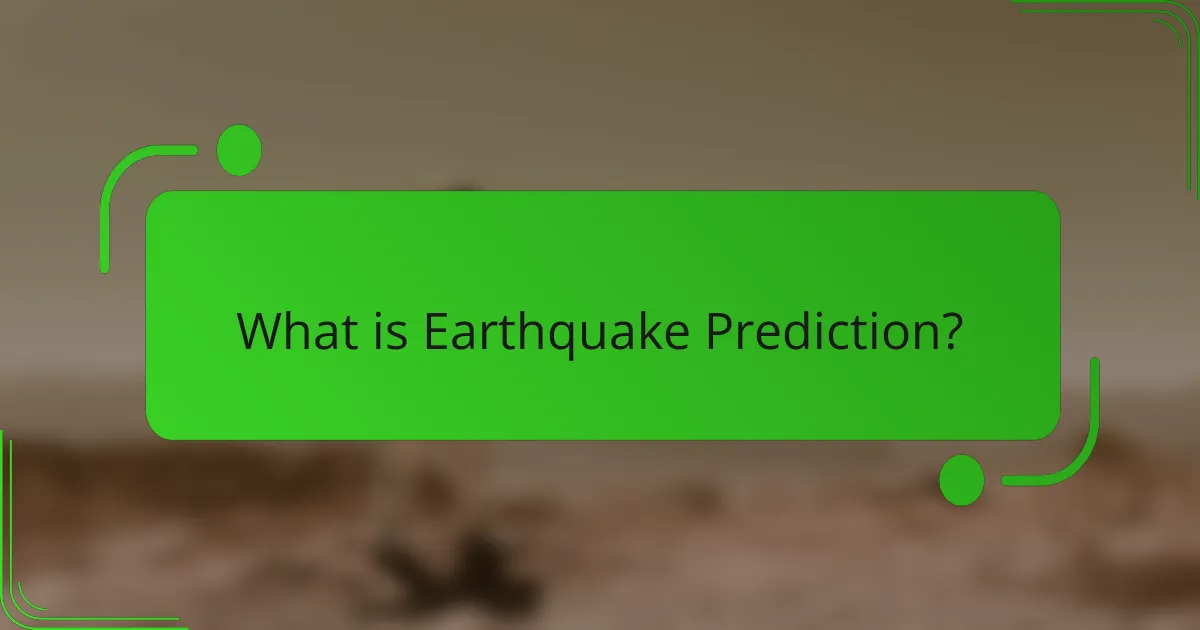
What is Earthquake Prediction?
Earthquake prediction is the process of forecasting the occurrence of an earthquake. It involves analyzing geological data and seismic activity patterns. Scientists use various methods to assess the likelihood of future earthquakes. These methods include monitoring fault lines and studying past seismic events. Despite advancements, accurate prediction remains challenging. Current techniques can estimate probabilities but not precise timing. Historical data shows that major earthquakes often occur without warning. Research continues to improve predictive models for better preparedness.
How is Earthquake Prediction defined in seismology?
Earthquake prediction in seismology is the attempt to forecast the occurrence of earthquakes. This involves identifying the time, location, and magnitude of potential seismic events. Various methods are used, including statistical analysis of historical data and monitoring of geological activity. Predictive models rely on understanding tectonic plate movements and stress accumulation in the Earth’s crust. Despite advancements, accurate prediction remains a challenge. Research indicates that while short-term predictions are difficult, long-term forecasts can provide valuable information. The complexity of geological systems contributes to the unpredictability of seismic events.
What are the historical perspectives on Earthquake Prediction?
Historical perspectives on earthquake prediction reveal a progression from ancient observations to modern scientific methods. Early civilizations, such as the Chinese and Greeks, noted patterns in animal behavior and natural phenomena before earthquakes. In the 20th century, advancements in seismology led to the development of seismic networks. These networks allowed for better data collection and analysis. The 1970s saw the introduction of the concept of foreshocks, which are smaller earthquakes preceding a larger event. Research in the 1990s focused on statistical models and the identification of precursors. Despite advances, reliable prediction remains elusive. The unpredictability of earthquakes has led to ongoing research and technological development in the field.
